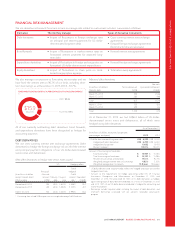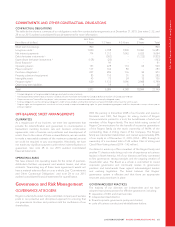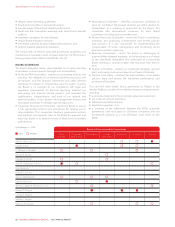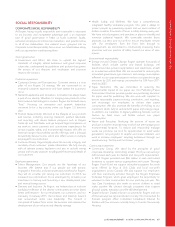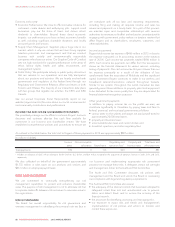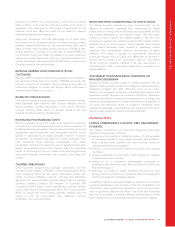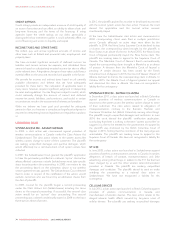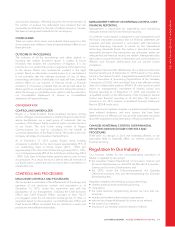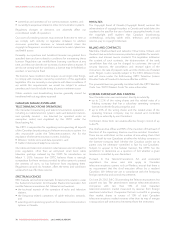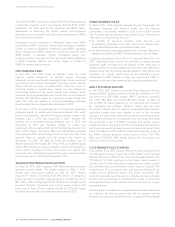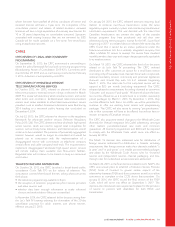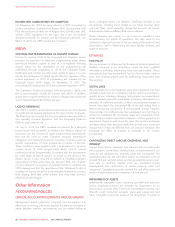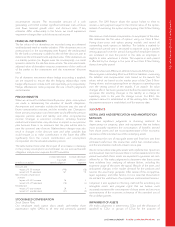Rogers 2015 Annual Report Download - page 73
Download and view the complete annual report
Please find page 73 of the 2015 Rogers annual report below. You can navigate through the pages in the report by either clicking on the pages listed below, or by using the keyword search tool below to find specific information within the annual report.
MANAGEMENT’S DISCUSSION AND ANALYSIS
distribution system, our cable services may face increased
competition. In addition, wireless Internet is, in some instances,
replacing traditional wireline Internet as the technology for wireless
Internet continues to develop.
The use of PVRs has affected our ability to generate television
advertising revenue because viewers can skip advertising aired on
the television networks. The continued emergence and growth of
subscriber-based satellite and digital radio products could have
affected change AM and FM radio audience listening habits and
have a negative effect on the results of our radio stations. Certain
audiences are also migrating away from traditional broadcast
platforms to the Internet as more video and audio content
streaming becomes available.
REGULATORY RISKS
CHANGES IN GOVERNMENT REGULATIONS
Substantially all of our business activities are regulated by ISED
Canada and/or the CRTC, and any regulatory changes or decisions
could adversely affect our consolidated results of operations. See
“Regulation in Our Industry” for more information.
Regulatory changes or decisions made by these regulators could
adversely impact our results on a consolidated basis. This regulation
relates to, among other things, licencing and related fees,
competition, the cable television programming services that we must
distribute, wireless and wireline interconnection agreements, the
rates we may charge to provide access to our network by third
parties, the resale of our networks and roaming on our networks, our
operation and ownership of communications systems, and our ability
to acquire an interest in other communications systems. In addition,
the costs of providing services may be increased from time to time as
a result of compliance with industry or legislative initiatives to address
consumer protection concerns or such Internet-related issues as
copyright infringement, unsolicited commercial e-mail, cybercrime,
and lawful access.
Generally, our licences are granted for a specified term and are
subject to conditions on the maintenance of these licences. These
licencing conditions and related fees may be modified at any time
by the regulators. The regulators may decide not to renew a licence
when it expires, and any failure by us to comply with the conditions
on the maintenance of a licence could result in a revocation or
forfeiture of any of our licences or the imposition of fines. Our
cable, wireless, and broadcasting licences generally may not be
transferred without regulatory approval.
The licences include conditions requiring us to comply with
Canadian ownership restrictions of the applicable legislation. We
are currently in compliance with all of these Canadian ownership
and control requirements. However, if these requirements were
violated, we would be subject to various penalties, possibly
including, in the extreme case, the loss of a licence.
SPECTRUM
Radio spectrum is one of the fundamental assets required to carry
on our Wireless business. Our ability to continue to offer and
improve current services and to offer new services depends on,
among other factors, continued access to, and deployment of,
adequate spectrum, including both the ability to renew current
spectrum licences and acquire new spectrum licences.
If we cannot acquire and retain needed spectrum, we may not be
able to continue to offer and improve our current services and
deploy new services on a timely basis, including providing
competitive data speeds that customers want. As a result, our ability
to attract and retain customers could be adversely affected. In
addition, an inability to acquire and retain needed spectrum could
affect network quality and result in higher additions to property,
plant and equipment.
Changes to government spectrum fees could significantly increase
our payments and therefore materially reduce our net income.
HIGHER HANDSET SUBSIDIES
Our wireless business model is based substantially on subsidizing
the cost of subscriber handsets, similar to other North American
wireless carriers. This model attracts customers and in exchange,
they commit to a term contract with us. We also commit to a
minimum subsidy per unit with the supplier of certain smartphone
devices. If we are unable to recover the costs of the subsidies over
the term of the customer contract, this could have an adverse effect
on our business, results of operations and financial condition.
THE WIRELESS CODE
The CRTC’s decision to implement its Wireless Code, among other
things, effectively required Canadian wireless carriers to move away
from offering three-year service contracts and instead offer two-year
contracts, and this affects our customer acquisition and retention
costs and subscriber churn. The code was applied to all contracts
(excluding enterprise plans) entered into or renewed after
December 2, 2013 and applied to contracts (excluding enterprise
plans), as of June 3, 2015, no matter when they were originally
entered into. See “Regulation in Our Industry” for more
information.
Our Wireless business could be adversely affected if laws,
regulation, or customer behaviour make it difficult for us to impose
term commitments or early cancellation fees on customers or
receive the service revenue we anticipate from the term
commitments.
NATIONAL WIRELESS TOWER POLICY
The policy affects all parties that plan to install or modify an antenna
system, including PCS, cellular, and broadcasting service providers.
The policy requires, among other things, that antenna proponents
consider using existing antenna structures before proposing new
structures and those owners of existing systems respond to
requests to share antenna systems. Antenna proponents must
follow a defined process for notifying the public and addressing
local requirements and concerns. Certain types of antenna
installations are excluded from the consultation requirements with
local authorities and the public. The policy could prevent us from
installing certain new antenna systems and/or expanding our
network, which would ultimately affect our ability to serve our
customers.
RADIO FREQUENCY EMISSIONS
From time to time, the media and other reports have highlighted
alleged links between radio frequency emissions from wireless
handsets and various health concerns, including cancer, and
interference with various medical devices, including hearing aids
2015 ANNUAL REPORT ROGERS COMMUNICATIONS INC. 71


